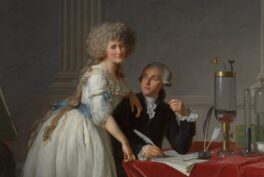Built by the self-described Sun King, Louis XIV, Versailles was the seat of power in France in the century running up to the French Revolution of 1789. With the help of three consecutive reigns of keen science-minded monarchs, Versailles at its peak was the place to be for artists, scientists, and craftspeople alike.
The new Science Museum exhibition does a masterful job at conveying quite how important Versailles was for the advancement of scientific knowledge. It does so by telling the story of the trailblazing innovations that first saw the light there.
Thirst for Knowledge
At the heart of Louis XIV’s and his successors’ vision of Versailles was the notion that knowledge is a source of prestige, wealth, and power. By meticulously constructing Versailles and its whole ecosystem, Louis XIV succeeded in establishing France as the center of scientific advancements in the Western world.
Knowledge was not only celebrated but sought after. The unfamiliar became something to study, document, and learn from as well as showcase. Non-native flora and fauna were of particular intrigue. In the exhibition, we can marvel at Louis XV’s magnificent rhino, still wonderfully preserved. We also see a painting of the first pineapple grown in a pot in the royal gardens and discover how Versailles scientists first attested that a potato is in fact edible. The exhibition, however, doesn’t shy away from the fact that these achievements came about due to France’s colonial exploitation of overseas territories and enslaved people.
Craftsmanship on Show
As well as knowledge, innovation was centerpiece of the vision of Versailles. Virtually all fields and forms of innovation found a home in the court—from botany, medicine, and astronomy to technology and warfare.
To suit the luxury of life in the Versailles court, scientists and craftspeople had to also be entertainers. Winning the favor of the court, and particularly of the king, was the aspiration of many. As a result, the displays became ever more daring and spectacular. Amongst them was the first flight of the Montgolfier—the hot-air balloon developed by the eponymous brothers. It flew from the gardens of Versailles in 1783, flying a sheep, a duck, and a cockerel for 3km before crashing down, wowing the court and winning the favor of Louis XVI.
The Art of Taking Time
Louis XIV remained in power for a jaw-dropping 72 years (and he still holds the record as the longest-reigning monarch of all time). His great-grandson Louis XV succeeded him aged five and reigned for an enviable 59 years. He was followed by his own grandson, Louis XVI, whose 18-year tenure was cut short by the French Revolution and subsequent abolition of monarchy. This continuity of power meant that those who were lucky enough to receive a commission from the king were not hurried to deliver. The value of taking the time to create something ground-breaking (and spectacular) was appreciated and welcomed.
Amongst the most interesting examples is a strikingly detailed map of the Moon, which took astronomer Jean-Dominique Cassini eight years to perfect. There is also an intricately detailed map of France that the authors, the Cassini family, worked on for over a century. Perhaps most impressive of all is a hugely complex pocket watch made by clockmaker Abraham-Louis Breguet for Marie Antoinette, wife of Louis XVI. In this case, the project, which took 40 years, was only completed in the 1820s—some decades after the death of the intended recipient in 1793.
The Women of the Court
The spirit of prioritizing scientific advancements meant that merit was given to talent and ideas before convention. So, unusually for the time, the court of Versailles was home to some trailblazing women who excelled in their field of work.
For example, the exhibition tells the story of Madeleine Françoise Basseporte, the first woman to be appointed official painter of the King’s Garden, through her botanically accurate prints. We read about the work of Gabrielle-Émilie du Châtelet, a scientist and mathematician renowned for translating Newton’s laws from Latin into French. We see the obstetrics model of Madame du Coudray and the chemistry lab model of Madame de Genlis, both used to teach their respective disciplines in new pioneering ways. We also learn about the perhaps more famous Madame de Pompadour, Louis XV’s mistress, and her work in supporting the creation of the Encyclopédie—the first encyclopedia.














